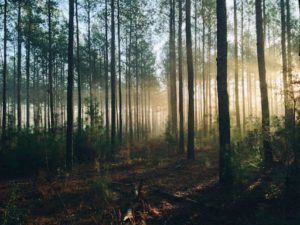Maine is 90% forested land – the highest percentage of any state in the United States. This includes the 12 million acres of forested land in the northern part of the state, with few people living there, and even fewer living there permanently. Three-quarters of the land is divided into two common types of forest groups, i.e., spruce-fir and maple/birch/beech.
The percentage of forested land has been relatively stable since 1960, with only a very a slight decline in timberland due to development an da booming population. Boundary marking is a standard practice in Maine to ensure lawful compliance, avoid timber harvesting on other people’s land, and prevent legal disputes between neighboring landowners.
We put together this quick guide to Maine boundary marking because we get a lot of questions about boundary lines and marking from clients preparing for a harvest. we hope to maximize your clarity on how boundary markers and surveys work in Maine.
 What Does it Mean to Establish Boundaries?
What Does it Mean to Establish Boundaries?
- An established boundary line means a property line demarcated using markings, monuments, pins, reference points, signs, or other markers to denote the ownership of land. These lines are marked upon mutual agreement between abutting landowners. Establishing boundaries requires historical physical evidence that there’s a preexisting boundary. Alternatively, a licensed land surveyor can also help to establish the boundary.
In the absence of monuments or blazes, only a professionally-licensed surveyor can establish the boundary line. The Maine State issues licenses for land surveyors under 32 MRSA § 13901 et. Seq. you can also find copies of this law and a list of practicing licensed land surveyors from the State Board of Licensure for Professional Land Surveyors.
- A licensed forester or landowner can reestablish or maintain a line where some blaze or monument still exists. If you cannot see a marker, you should get the line surveyed by a land surveyor. Previous lines may have been corrected, and the surveyor can relocate and/or reestablish them by conducting an accurate survey.
- Monuments are permanent markers such as iron bars or stone posts that a surveyor establishes. Blazes, on the other hand, are only line locators and are naturally less visible over time.
- Before you permanently mark the property line with paint or blaze, make sure to walk along the line with the neighboring landowner to ensure mutual agreement on the location. In case of disagreement, the line is surveyed. Landowners can share the cost, but it should be agreed upon before the survey.
Maine Boundary Marking Methods
There are different ways a land surveyor will mark your boundaries. Some of the methods are given below:
Brush and Spot/Blaze
This is the commonly used method for boundary lines that run through woods and can last you a lifetime. Smaller trees are cut and removed, whereas larger trees along the boundary line are spotted or blazed.
Spotted or blazed trees have oval-shaped scars and missing bark. The bark closes as the tree heals, but the surveyor will be able to go back years and identify the blaze. Technological advancements such as GPS have changed the way boundary marking works nowadays.
This method also saves cost, but in case of boundary disputes or plow trucks, the monument may get removed, which means the spotting or blazing line can get lost in the process.
Hang Flags
Another well-suited method for Maine boundary marking is flagging. Surveyors use tape to tie trees and branches and use GPS technology. The flagging breaks, cracks, and ages as the trees grow, the wind blows, and the sun shines. This is one of the drawbacks of this marking method. It isn’t permanent, but it will last a while.
Grade Stakes
Grade stakes are set at intermediate points on a property line to identify where the line is. This method also shows that the Maine boundary marking code is being followed. Wooden grade stakes also help to mark a boundary in an open field with no trees to flag, blaze, or spot. However, wooden-grade stakes don’t last a lifetime. They have a maximum life expectancy of two years.
Alternatively, there are metal stakes that you can use for boundary marking. They also last longer than wooden stakes. Fiberglass stakes are another suitable option. They’re sturdier than flagging or wooden stakes and less costly than metal ones.
How To Mark Boundary in Maine?
If you know your property lines, do this:
- Paint boundaries with durable paint intended for the purpose. Use dark colors such as red, blue, yellow, or orange. If you want to mark your land for no trespassing, you need to use the state’s standard color for this purpose: OSHA purple or a near match.
- Brush or clean out boundary lines for easy traveling.
- Use permanent material for corner posts and paint them clearly.
As master loggers, William A. Day Jr. & Sons is focused on ensuring that your timber harvest goes perfectly with smooth operation. Surveying your land and boundary marking is the foundation for a legal and productive timber harvest. If you’re looking for recommendations on licensed land surveyors in Maine or other forestry contractors, give us a call today!
